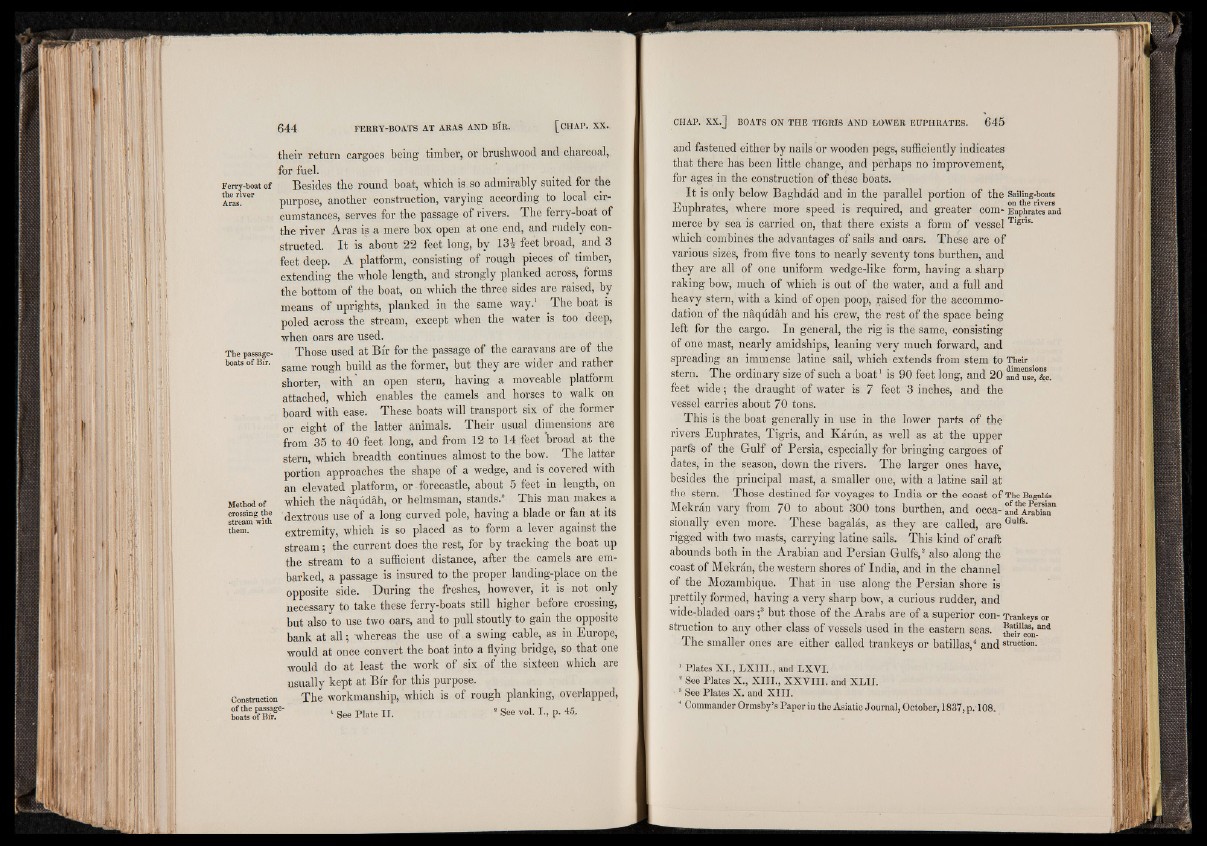
Ferry-boat of
the river
Aras.
The passage-
boats of Bir.
Method of
crossing the
stream with
them.
their return cargoes being timber, or brushwood and charcoal,
for fuel.
Besides the round boat, which is so admirably suited for the
purpose, another construction, varying according to local circumstances,
Construction
of the passage-
boats of Bir.
serves for the passage of rivers. The ferry-boat of
the river Aras is a mere box open at one end, and rudely constructed.
It is about 22 feet long, by 134 feet broad, and 3
feet deep. A platform, consisting of rough pieces of timber,
extending the whole length, and strongly planked across, forms
the bottom of the boat, on which the three sides are raised, by
means of uprights, planked in the same way.1 The boat is
poled across the stream, except when the water is too deep,
when oars are used.
Those used at Bir for the passage of the caravans are of the
same rough build as the former, but they are wider and rather
shorter, with' an open stern, having a moveable platform
attached, which enables the camels and horses to walk on
board with ease. These boats will transport six of the former
or eight of the latter animals. Their usual dimensions are
from 35 to 40 feet long, and from 12 to 14 feet broad at the
stern, which breadth continues almost to the bow. The latter
portion approaches the shape of a wedge, and is covered with
an elevated platform, or forecastle, about 5 feet in length, on
which the naqudah, or helmsman, stands.2 This man makes a
dextrous use of a long curved pole, having a blade or fan at its
extremity, which is so placed as to form a lever against the
stream; the current does the rest, for by tracking the boat up
the stream to a sufficient distance, after the camels are embarked,
a passage is insured to the proper landing-place on the
opposite side. During the freshes, however, it is not only
necessary to take these ferry-boats still higher before crossing,
but also to use two oars, and to pull stoutly to gain the opposite
bank at all; whereas the use of a swing cable, as in Europe,
would at once convert the boat into a flying bridge, so that one
would do at least the work of six of the sixteen which are
usually kept at Bir for this purpose.
The workmanship, which is of rough planking, overlapped,
1 See Plate I I . ! See vol. I ., p. 45,
and fastened either by nails or wooden pegs, sufficiently indicates
that there has been little change, and perhaps no improvement,
for ages in the construction of these boats.
It is only below Baghdad and in the parallel portion of the Saiiing-boats
Euphrates, where more speed is required, and greater com- Euphratesand
merce by sea is carried on, that there exists a form of vessel Tlgrls‘
which combines the advantages of sails and oars. These are of
various sizes, from five tons to nearly seventy tons burthen, and
they are all of one uniform wedge-like form, having a sharp
raking bow, much of which is out of the water, and a full and
heavy stern, with a kind of open poop, raised for the accommodation
of the nâqudâh and his crew, the rest of the space being
left for the cargo. In general, the rig is the same, consisting
of one mast, nearly amidships, leaning very much forward, and
spreading an immense latine sail, which extends from stem to l i p
stern. The ordinary size of such a boat1 is 90 feet long, and 20 anïuse,™c.
feet wide; the draught of water is 7 feet 3 inches, and the
vessel carries about 70 tons.
This is the boat generally in use in the lower parts of the
rivers Euphrates, Tigris, and Karun, as well as at the upper
parts of the Gulf of Persia, especially for bringing cargoes of
datés, in the season, down the rivers. The larger ones have,
besides the principal mast, a smaller one, with a latine sail at
the stern. Those destined for voyages to India or the coast of The Bagaiâs
Mekran vary from 70 to about 300 tons burthen, and occa-andArabhiT
sionally even more. These bagalas, as they are called, are Gulfs-
rigged with two masts, carrying latine sails. This kind of craft
abounds both in the Arabian and Persian Gulfs,2 also along the
coast of Mekran, the western shores of India, and in the channel
of the Mozambique. That in use along the Persian shore is
prettily formed, having a very sharp bow, a curious rudder, and
wide-bladed oars ;3 but those of the Arabs are of a superior con- Trankeya or
struction to any other class of vessels used in the eastern seas. Sa1llas’and rn i n • tneir con- I he smaller ones are either called trankeys or hatillas,1 andstraction-
1 Plates X I., L X I I I ., and LX V I.
2 See Plates X., X I I I ., X X V I I I . and X L II.
8 See Plates X. and X I I I .
1 Commander Ormsby’s Paper in the Asiatic Journal, October, 1837, p. 108.